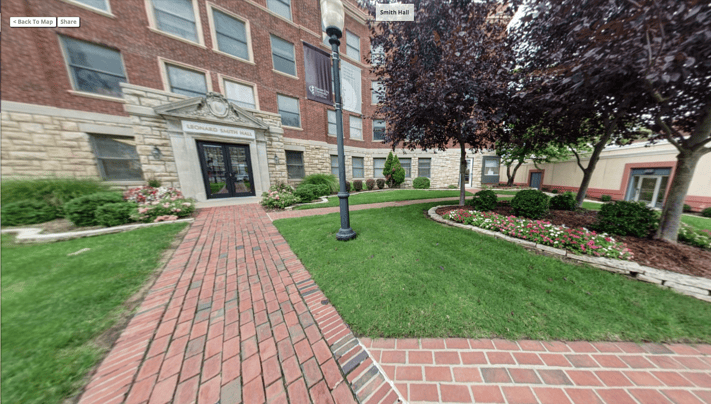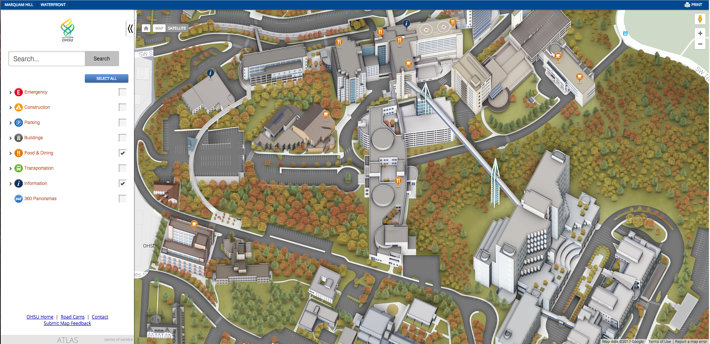Interactive Hospital Maps – Meeting the Unique Wayfinding and Visitor Needs at Health Centers
Interactive hospital maps and media – such as video, virtual tours, and 360-degree photospheres – can improve your visitor experience.
Finding one’s way around a hospital or medical campus can be like finding your way through a labyrinth. But – aside from the everyday navigational challenges – health care facilities also have a high quantity of first-time patients and visitors arriving every day.
Oregon Health and Sciences University (OHSU) – a leading US medical campus with two working hospitals – provides a great example of how the atlas3D interactive mapping and media platform can benefit even the most complex of health care centers, hospitals and medical campuses. OHSU’s Marquam Hill campus is located in Portland. In some of its buildings you enter on the first floor; others on the ninth floor! As you can guess, this can create great confusion (and anxiety) in patients, visitors and even staff who are still learning their way around.
OHSU selected the atlas3D platform to complement a broader wayfinding strategy to make it easier and more intuitive to navigate the campus, grounds and facilities.
atlas3D’s detailed map allows visitors to navigate their way to and through the OHSU campus. They can start days before on their desktop (and print out a custom map to their liking), and/or at any point on- or off-campus on a mobile device. Meanwhile, the atlas3D content management software for interactive media allows visitors to search for and explore buildings, parking lots, specific routes, and even to orient themselves by viewing any of the XXX number of 360 degree photospheres.
Have a look at how OHSU benefits from atlas3D interactive maps.
As a hospital facility manager, property manager or health care communications lead, have you found yourself searching for a better way to help visitors find their way around? Ideally, a solution that’s easily sharable and also demonstrates your professionalism and dedication to providing cutting-edge health care and providing the best visitor experience?
Here are a few ways that interactive maps can benefit your patients, staff and visitors, using examples from medical hospitals and health care campuses across the U.S.
Create a Map Layer for First-Time Patients
No doubt you have new patients coming in to your medical facility every day. Perhaps you’ve given up using basic online sky-view maps because they don’t provide enough detail. The same goes for Google mapping, especially if you reside in a wooded area where trees frequently obscure clear views of your campus, or if Google driving directions habitually lead your visitors to the wrong location(s).
Kansas City University of Medicine and Biosciences is another atlas3D client. Through their interactive map and media, patients and visitors can easily navigate via the map legend on the left of the screen. These toggle on/off categories allow visitors to see mapping details beyond the general – including pedestrian crossings, parking, service buildings, and even ADA accessible parking and building entrances. The university added virtual tour so patients feel like they’ve already visited there before they arrive.
Below is a portion of the 360 degree panorama of KCUMB’s Smith Hall.

Create a Map Layer for New Medical Staff
You likely have new medical staff regularly showing up for their new position. This is yet another challenge that interactive mapping – and a specific category that toggles a map layer – can solve. In fact, OHSU found that their staff frequently use their interactive map to provide colleagues with specific, cross-campus directions to a building or room.
New York Medical College is another prestigious medical campus using the atlas3D platform. For new medical staff needing to familiarize themselves with the campus, they again can do so with a convenient legend. .
Here, new staff can get immediate clear information on NYMC’s points of interest, specific medical buildings, and even public transportation mapping. Transportation can be an extremely helpful category, especially for commuting staff or patients coming from outside the area.
Reduce Anxiety in Patients and Students
For those needing care or arriving for study, visiting a large health care facility for the first time can be an overwhelming experience. This could bring additional – and unnecessary – anxiety around an upcoming procedure, getting acclimated for the first week of classes, or showing up for the first day of residency.
Digital hospital maps can help reduce anxiety, by allowing patients and other visitors to get a feel for where they are going, perhaps take a virtual tour of a specific facility (imagine – for starters – the popularity of a Maternity Care virtual tour…you could even show views from specific rooms).
Augusta University Medical Center uses atlas3D to profile not only their facilities (and three separate campuses!), but also to highlight the beauty of the surrounding area (Masters, anyone?). And a virtual tour of the Augusta University’s Health Sciences campus makes it easy to orient yourself with the area and view both existing and planned facilities.
Interested in hearing how interactive hospital maps and media can help improve the guest experience at your health care campus or facility?
We’d welcome the chance to chat. Contact us today! And we hope to see you at ASHE.

